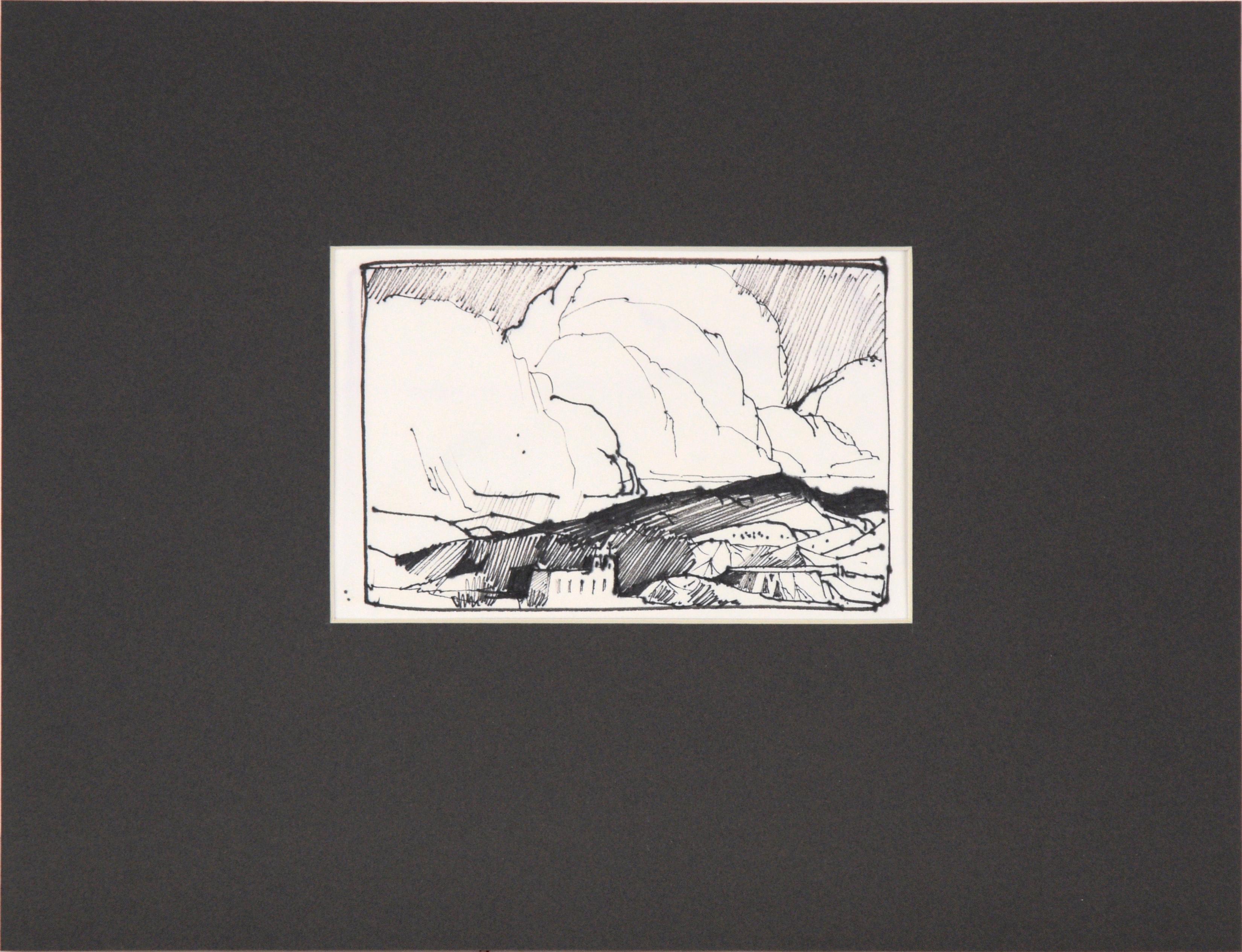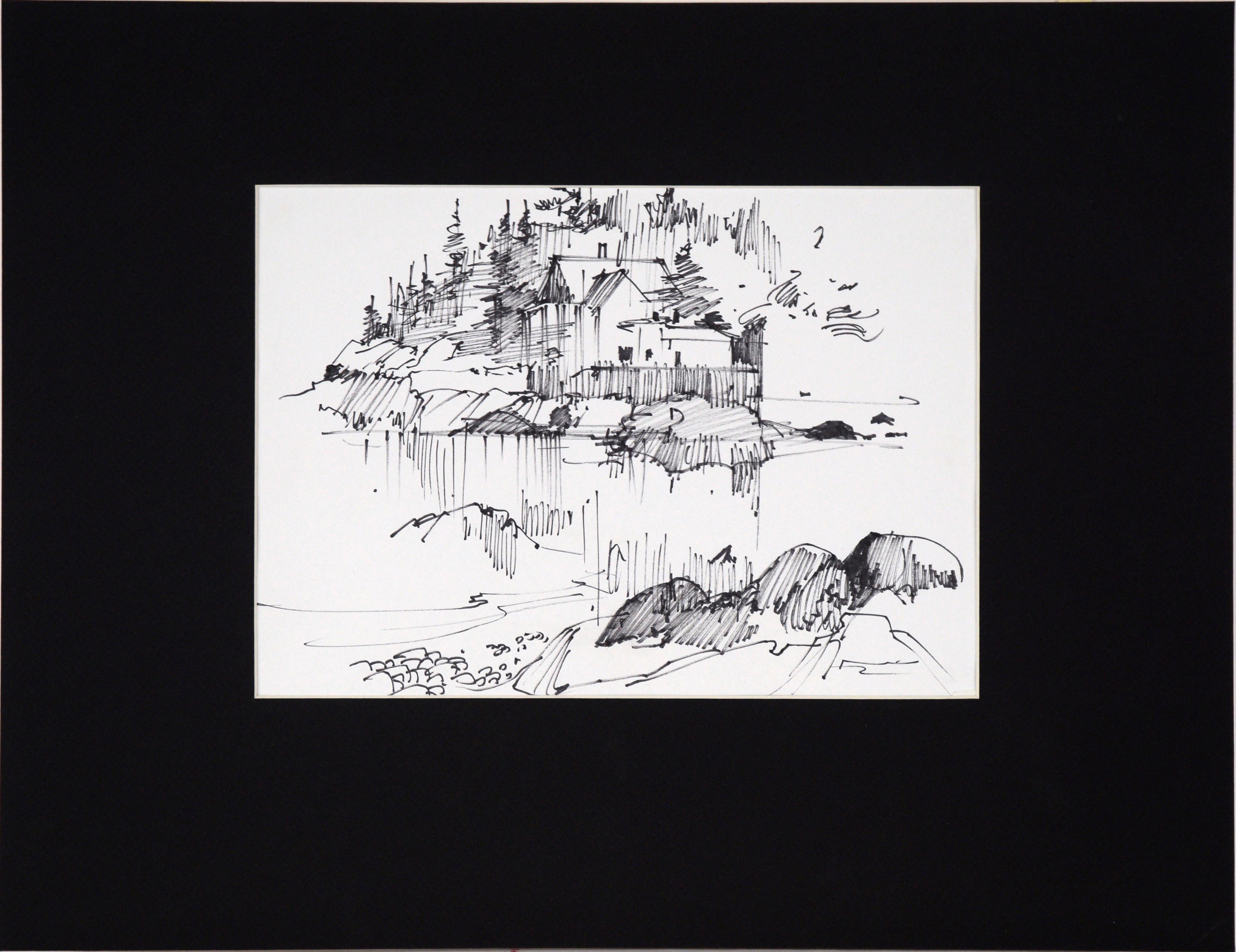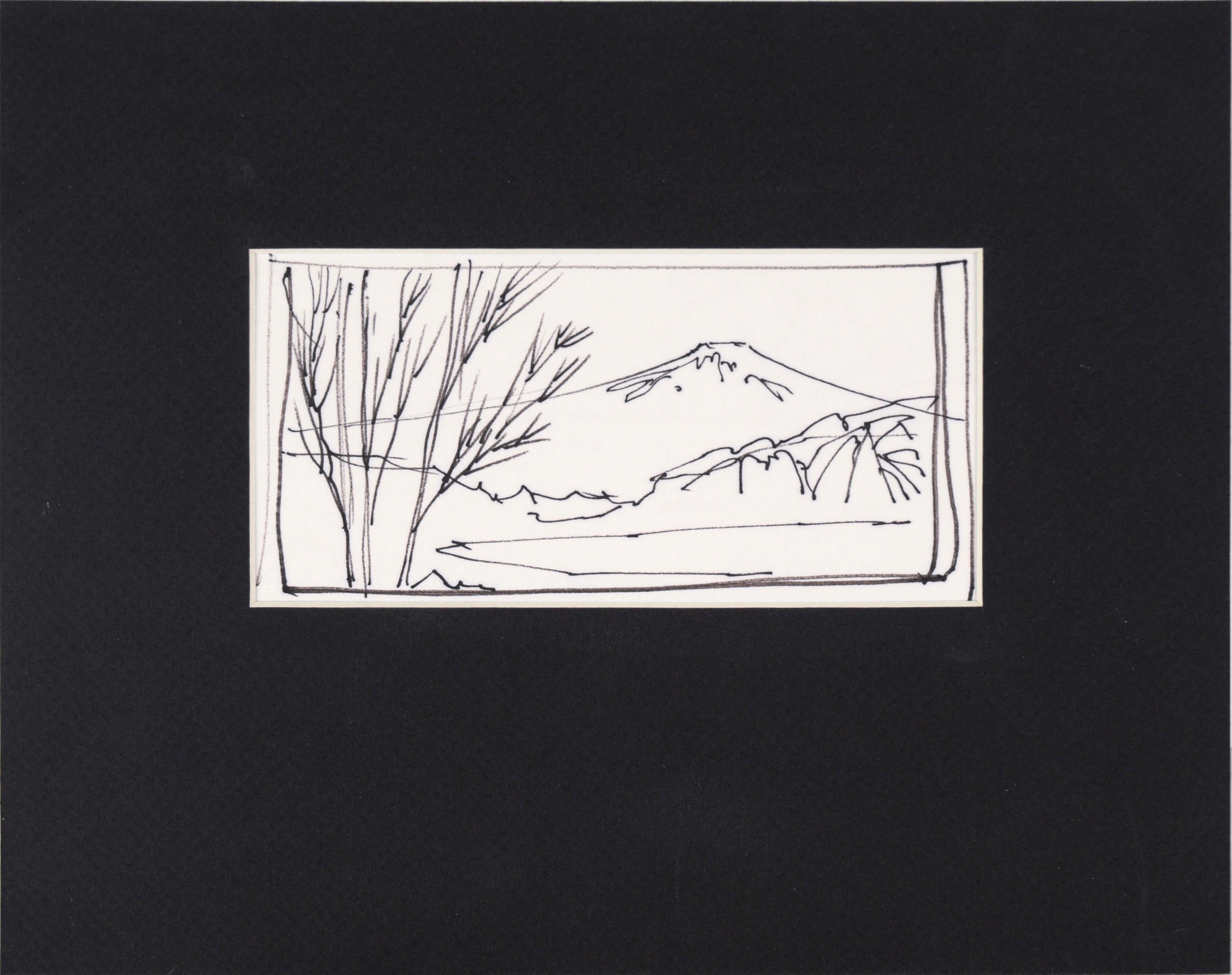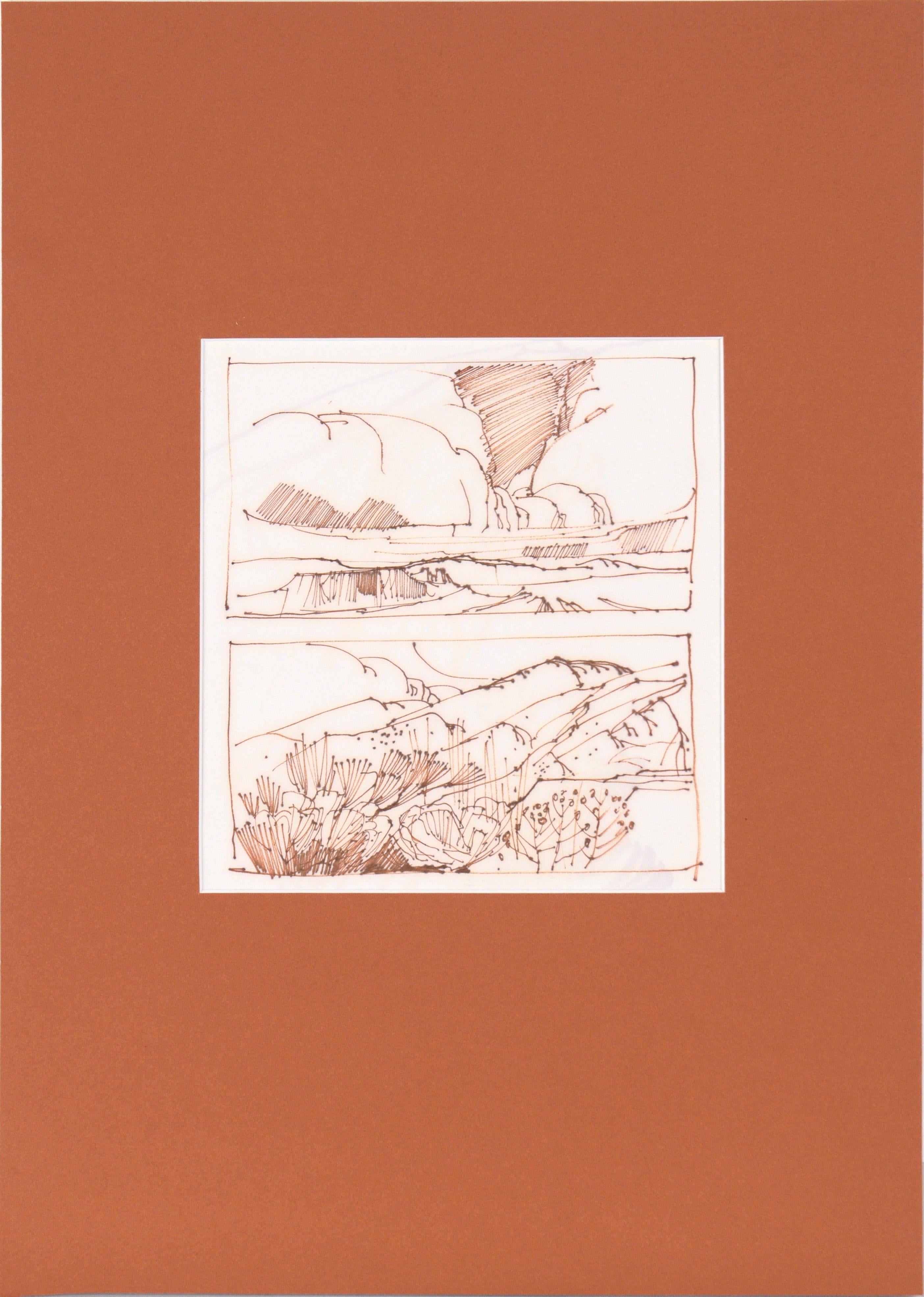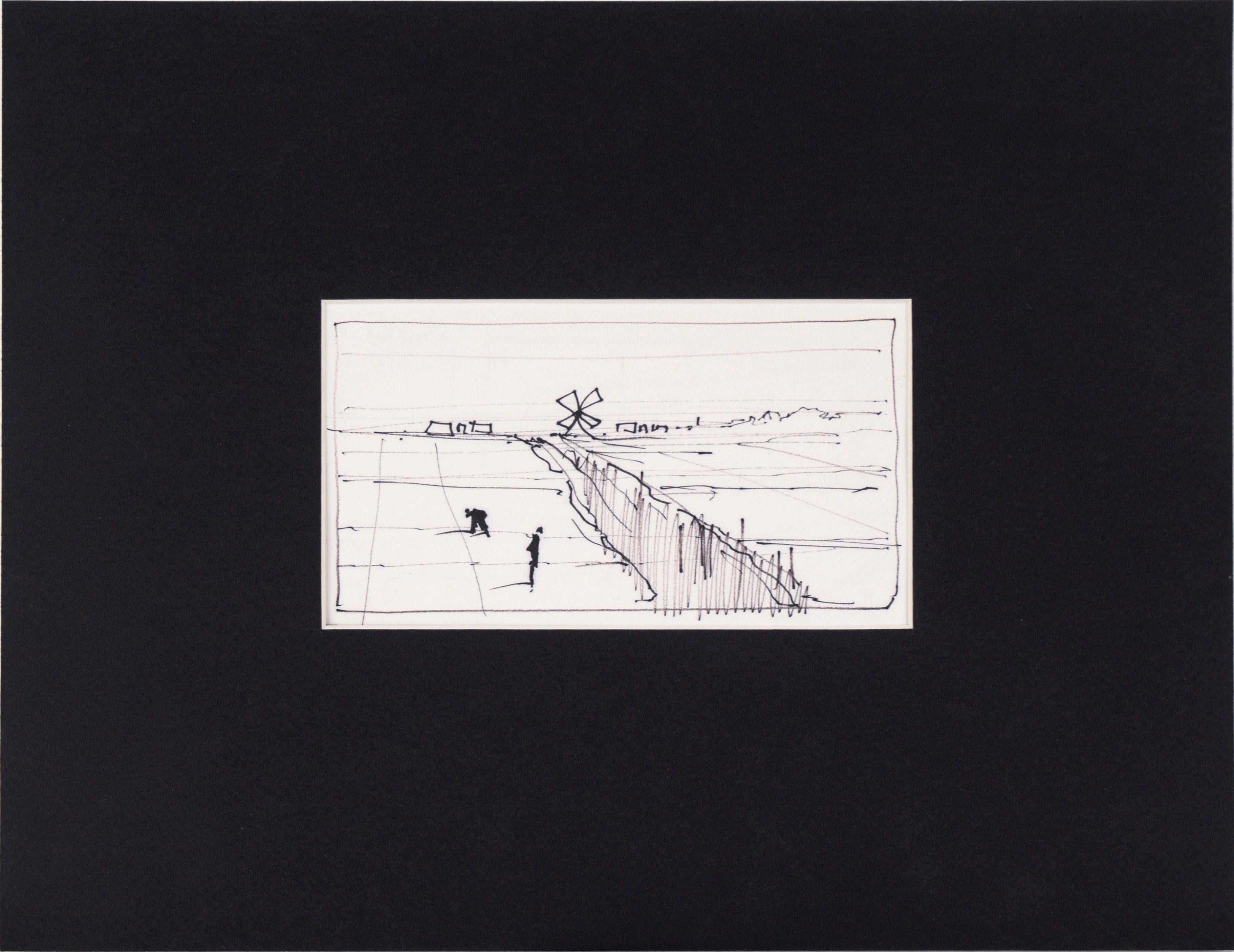Items Similar to Grand Canyon Plateau - Line Drawing Landscape in Ink on Paper
Want more images or videos?
Request additional images or videos from the seller
1 of 6
Laurence SissonGrand Canyon Plateau - Line Drawing Landscape in Ink on Paperlate 20th Century
late 20th Century
About the Item
Grand Canyon Plateau - Line Drawing Landscape in Ink on Paper
Bold landscape line drawing by listed Maine artist Laurence Sisson (American, 1928-2015). Towering canyon walls frame a river snaking round a central plateau. This drawing was likely a preparatory sketch for a larger painting.
This piece is unsigned, but was acquired from David Sisson, the artist's son. Copy of the letter of authentication included.
Presented in a new black mat with foam-core backing.
Mat size: 8"H x 10"W
Image size: 3.38"H x 6.63"W
Laurence Sisson, was a student of Herbert Barnett (1910-1972), he was one of America's preeminent realist painters today. His work may be found in the permanent collections of museums nationwide including the Museum of Fine Arts, Boston, and the Portland Museum of Art, Maine.
Laurence Sisson painted landscapes for sixty years. He was known for his paintings of the Maine coast and landscapes of the southwest. His style ranges from plein air watercolors to large oil landscapes with abstract and surrealist elements. Laurence Sisson spent 50 years living in both areas of the United States yet he notes the most influential place for his artistic development was the time he spent in Japan as a young man.
Laurence Sisson was been a talented painter as a child and attended art classes at the Worcester Art museum in Massachusetts. Sisson painted professionally while in his early twenties though he had not decided to devote his life to art. While serving in the military during the United States occupation of Japan after War World II he was assigned to decorate the general's residence in Yokohama. This assignment forced him to learn all he could about the land and culture of Japan and by the time he left he was changed as an artist and man.
Sisson describes this period of his painting as when he began "designing nature." His work appears to be a response to traditional Asian landscape painting, his Yankee sensibility and western art training at Yale summer school. His landscapes of both Maine and the southwest are inspired by real locations, but are in fact imaginary landscapes.
Sisson was the youngest member of the Watercolor Society of America.
- Creator:Laurence Sisson (1928, American)
- Creation Year:late 20th Century
- Dimensions:Height: 8 in (20.32 cm)Width: 10 in (25.4 cm)Depth: 0.25 in (6.35 mm)
- Medium:
- Movement & Style:
- Period:
- Condition:Overall, very good condition. Mat is new.
- Gallery Location:Soquel, CA
- Reference Number:
Laurence Sisson
Laurence Sisson, was a student of Herbert Barnett (1910-1972), he was one of America's preeminent realist painters today. His work may be found in the permanent collections of museums nationwide including the Museum of Fine Arts, Boston, and the Portland Museum of Art, Maine. Laurence Sisson painted landscapes for sixty years. He was known for his paintings of the Maine coast and landscapes of the southwest. His style ranges from plein air watercolors to large oil landscapes with abstract and surrealist elements. Laurence Sisson spent 50 years living in both areas of the United States yet he notes the most influential place for his artistic development was the time he spent in Japan as a young man. Laurence Sisson was been a talented painter as a child and attended art classes at the Worcester Art museum in Massachusetts. Sisson painted professionally while in his early twenties though he had not decided to devote his life to art. While serving in the military during the United States occupation of Japan after War World II he was assigned to decorate the general's residence in Yokohama. This assignment forced him to learn all he could about the land and culture of Japan and by the time he left he was changed as an artist and man. Sisson describes this period of his painting as when he began "designing nature." His work appears to be a response to traditional Asian landscape painting, his Yankee sensibility and western art training at Yale summer school. His landscapes of both Maine and the southwest are inspired by real locations, but are in fact imaginary landscapes. Sisson was the youngest member of the Watercolor Society of America.
About the Seller
4.9
Platinum Seller
These expertly vetted sellers are 1stDibs' most experienced sellers and are rated highest by our customers.
Established in 1986
1stDibs seller since 2014
2,520 sales on 1stDibs
Typical response time: <1 hour
- ShippingRetrieving quote...Ships From: Soquel, CA
- Return PolicyA return for this item may be initiated within 14 days of delivery.
More From This SellerView All
- Big Cloud, Line Drawing LandscapeBy Laurence SissonLocated in Soquel, CABold landscape line drawing with big clouds over a desert landscape by listed Maine artist Laurence Sisson (American, 1928-2015). This piece is unsigned, but was acquired from David Sisson, the artist's son (intialed D.S.) Presented in a new black mat with foam-core backing. Image size: 6.5"H x 12.5"W. Laurence Sisson, was a student of Herbert Barnett (1910-1972), he was one of America's preeminent realist painters today. His work may be found in the permanent collections of museums nationwide including the Museum of Fine Arts, Boston, and the Portland Museum of Art, Maine. Laurence Sisson painted landscapes for sixty years. He was known for his paintings of the Maine coast...Category
Late 20th Century American Impressionist Landscape Drawings and Watercolors
MaterialsPermanent Marker, Paper
- Clouds Above the High Desert - Line Drawing Landscape in Ink on PaperBy Laurence SissonLocated in Soquel, CAClouds Above the High Desert - Line Drawing Landscape in Ink on Paper Bold landscape line drawing by listed Maine artist Laurence Sisson (American, 1928-2015). Giant cumulous clouds...Category
Late 20th Century American Impressionist Landscape Drawings and Watercolors
MaterialsPaper, Permanent Marker
- House Across the Lake - Line Drawing Landscape in Ink on PaperBy Laurence SissonLocated in Soquel, CAHouse Across the Lake - Line Drawing Landscape in Ink on Paper Delicate landscape line drawing by listed Maine artist Laurence Sisson (American, 1928-2015). The viewer stands at the...Category
Late 20th Century American Impressionist Landscape Drawings and Watercolors
MaterialsPaper, Permanent Marker
- Snow-Capped Mountain Lake - Line Drawing Landscape in Ink on PaperBy Laurence SissonLocated in Soquel, CASnow-Capped Mountain Lake - Line Drawing Landscape in Ink on Paper Bold landscape line drawing by listed Maine artist Laurence Sisson (American, 1928-2015). A snow-capped mountain stands above a lake with a tree in the foreground. This drawing was likely a preparatory sketch for a larger painting. This piece is unsigned, but was acquired from David Sisson, the artist's son. Letter of authentication included. Presented in a new black mat with foam-core backing. Mat size: 8"H x 10"W Image size: 3"H x 6.63"W Laurence Sisson, was a student of Herbert Barnett (1910-1972), he was one of America's preeminent realist painters today. His work may be found in the permanent collections of museums nationwide including the Museum of Fine Arts, Boston, and the Portland Museum of Art, Maine. Laurence Sisson painted landscapes for sixty years. He was known for his paintings of the Maine coast and landscapes of the southwest. His style ranges from plein air watercolors to large oil landscapes...Category
Late 20th Century American Impressionist Landscape Drawings and Watercolors
MaterialsPermanent Marker, Paper
- Two High Desert Landscapes - Line Drawing in Sepia-Toned Ink on PaperBy Laurence SissonLocated in Soquel, CATwo High Desert Landscapes - Line Drawing in Sepia-Toned Ink on Paper Bold landscape line drawings by listed Maine artist Laurence Sisson (American, 1928-2015). In the top image, giant cumulous clouds hang over the desert plateaus of varying heights. In the bottom image, desert brush fill the foreground with rocky mountains and big clouds towering over. These drawings were likely preparatory sketches for larger paintings. This piece is unsigned, but was acquired from David Sisson, the artist's son. Copy of a signed letter of authentication included Presented in a new orange mat with foam-core backing. Mat size: 19"H x 13"W Image size: 10.63"H x 7.75"W Laurence Sisson, was a student of Herbert Barnett (1910-1972), he was one of America's preeminent realist painters today. His work may be found in the permanent collections of museums nationwide including the Museum of Fine Arts, Boston, and the Portland Museum of Art, Maine. Laurence Sisson painted landscapes for sixty years. He was known for his paintings of the Maine coast and landscapes of the southwest. His style ranges from plein air watercolors to large oil landscapes...Category
Late 20th Century American Impressionist Landscape Drawings and Watercolors
MaterialsPaper, Permanent Marker
- Tending the fields - Windmill - Line Drawing Landscape in Ink on PaperBy Laurence SissonLocated in Soquel, CATending the fields - Line Drawing Landscape in Ink on Paper Bold landscape line drawing by listed Maine artist Laurence Sisson (American, 1928-2015). Two figures bent over the field...Category
Late 20th Century American Impressionist Landscape Drawings and Watercolors
MaterialsPaper, Permanent Marker
You May Also Like
- Mount MonadnockBy Frank Weston BensonLocated in Milford, NHAn exceptional watercolor of Mount Monadnock snow capped in winter in New Hampshire by American artist Frank Weston Benson (1862-1951). Benson was born in Salem, Massachusetts and went on to study in Boston at the Museum School of Fine Arts and later with Julian Lefebvre and Gustave Boulanger at the Academie Julian in Paris. Benson was well known for his impressionist landscapes and seascapes, and etchings of hunting scenes. Watercolor on paper, signed lower left F.W. Benson with inscription “To Mrs Bush,” titled on Vose Galleries...Category
Early 20th Century American Impressionist Landscape Drawings and Waterco...
MaterialsWatercolor, Paper
- "Horse Cart"By Daniel GarberLocated in Lambertville, NJJim’s of Lambertville Fine Art Gallery is proud to present this piece by Daniel Garber (1880 - 1958). One of the two most important and, so far, the most valuable of the New Hope Sc...Category
Early 20th Century American Impressionist Landscape Drawings and Waterco...
MaterialsGraphite, Paper
- "Bare Tree"By Daniel GarberLocated in Lambertville, NJJim’s of Lambertville Fine Art Gallery is proud to present this piece by Daniel Garber (1880 - 1958). One of the two most important and, so far, the most valuable of the New Hope School Painters, Daniel Garber was born on April 11, 1880, in North Manchester, Indiana. At the age of seventeen, he studied at the Art Academy of Cincinnati with Vincent Nowottny. Moving to Philadelphia in 1899, he first attended classes at the "Darby School," near Fort Washington; a summer school run by Academy instructors Anshutz and Breckenridge. Later that year, he enrolled at the Pennsylvania Academy of the Fine Arts. His instructors at the Academy included Thomas Anshutz, William Merritt Chase and Cecilia Beaux. There Garber met fellow artist Mary Franklin while she was posing as a model for the portrait class of Hugh Breckenridge. After a two year courtship, Garber married Mary Franklin on June 21, 1901. In May 1905, Garber was awarded the William Emlen Cresson Scholarship from the Pennsylvania Academy, which enabled him to spend two years for independent studies in England, Italy and France. He painted frequently while in Europe, creating a powerful body of colorful impressionist landscapes depicting various rural villages and farms scenes; exhibiting several of these works in the Paris Salon. Upon his return, Garber began to teach Life and Antique Drawing classes at the Philadelphia School of Design for Women in 1907. In the summer of that same year, Garber and family settled in Lumbertville, Pennsylvania, a small town just north of New Hope. Their new home would come to be known as the "Cuttalossa," named after the creek which occupied part of the land. The family would divide the year, living six months in Philadelphia at the Green Street townhouse while he taught, and the rest of the time in Lambertville. Soon Garber’s career would take off as he began to receive a multitude of prestigious awards for his masterful Pennsylvania landscapes. During the fall of 1909, he was offered a position to teach at the Pennsylvania Academy as an assistant to Thomas Anshutz. Garber became an important instructor at the Academy, where he taught for forty-one years. Daniel Garber painted masterful landscapes depicting the Pennsylvania and New Jersey countryside surrounding New Hope. Unlike his contemporary, Edward Redfield, Garber painted with a delicate technique using a thin application of paint. His paintings are filled with color and light projecting a feeling of endless depth. Although Like Redfield, Garber painted large exhibition size canvases with the intent of winning medals, and was extremely successful doing so, he was also very adept at painting small gem like paintings. He was also a fine draftsman creating a relatively large body of works on paper, mostly in charcoal, and a rare few works in pastel. Another of Garber’s many talents was etching. He created a series of approximately fifty different scenes, most of which are run in editions of fifty or less etchings per plate. Throughout his distinguished career, Daniel Garber was awarded some of the highest honors bestowed upon an American artist. Some of his accolades include the First Hallgarten Prize from the National Academy in 1909, the Bronze Medal at the International Exposition in Buenos Aires in 1910, the Walter Lippincott Prize from the Pennsylvania Academy and the Potter Gold Medal at the Art Institute of Chicago in 1911, the Second Clark Prize and the Silver Medal from the Corcoran Gallery of Art for “Wilderness” in 1912, the Gold Medal from the Panama-Pacific Exposition in San Francisco of 1915, the Second Altman Prize in1915, the Shaw prize in 1916, the First Altman Prize in 1917, the Edward Stotesbury Prize in1918, the Temple Gold Medal, in 1919, the First William A...Category
Early 20th Century American Impressionist Landscape Drawings and Waterco...
MaterialsCharcoal, Paper
- "Lunch at the Stockton Inn"By Daniel GarberLocated in Lambertville, NJJim’s of Lambertville is proud to offer this artwork. Signed lower left. Pencil drawing. Complemented by a hand carved and gilt frame. Daniel Garber (1880-1958) ...Category
20th Century American Impressionist Landscape Drawings and Watercolors
MaterialsPaper, Pencil
- "Central Park"By William Langson LathropLocated in Lambertville, NJJim’s of Lambertville is proud to offer this artwork. Signed. Complemented by a hand carved and gilt frame. William L. Lathrop (1859-1938) Deemed “Father of the New Hope Art Colony”, William Langson Lathrop was born in Warren, Illinois. He was largely self-taught, having only studied briefly with William Merritt Chase in 1887, at the Art Students League. Lathrop first moved east in the early 1880s, and took a job at the Photoengraving Company in New York City. While there, he befriended a fellow employee, Henry B. Snell. The two men became lifelong friends and ultimately, both would be considered central figures among the New Hope Art Colony. Lathrop's early years as an artist were ones of continuing struggle. His efforts to break through in the New York art scene seemed futile, so he scraped enough money together to travel to Europe with Henry Snell in1888. There he met and married an English girl, Annie Burt. Upon returning to New York, he tried his hand at etching, making tools from old saw blades. Even though his prints were extremely beautiful, he still was impoverished. Lathrop would return to his family in Ohio, before once again attempting the New York art scene. In 1899, with great trepidation, he submitted five small watercolors to an exhibit at the New York Watercolor Club. He won the Evans Prize, the only award given, and four of the five paintings were sold the opening night. At age forty Lathrop’s career would finally take off and he became an “overnight success Lathrop came to Phillips Mill for the first time in1898, to visit his boyhood friend, Dr. George Marshall. Shortly after, he and his family purchased the old miller’s house from Dr. Marshall. The Lathrop’s home became a social and artistic center for the growing New Hope colony. Tea and fascinating conversation was the “order of the day” every Sunday. This was a scene fondly recalled by many younger art students that Lathrop taught privately at Phillips Mill. It was common to see groups of his students painting and sketching along the banks of the canal or aboard his canal boat. He had previously taught in the Poconos and at the Lyme, Connecticut Summer School in1907, but Phillips Mill always remained Lathrop’s permanent address. In 1928, a committee headed by Lathrop was formed to purchase the old Phillips Mill building as a place to hold community gatherings and art exhibitions. The committee had success and in 1929 the Phillips Mill Community Association was formed. This became the center of the New Hope Art Colony holding annual exhibitions and still operating today. In 1930, Lathrop had built a sailboat he named the “Widge”. For eight consecutive seasons he sailed it along the coast of Long Island...Category
Early 20th Century American Impressionist Landscape Drawings and Waterco...
MaterialsGraphite, Paper
- "Old Russell House, " Charles Marion Russell, Western American DrawingBy Charles Marion RussellLocated in New York, NYCharles Marion Russell (1864 - 1926) Old Russell House Pencil on paper 3 1/2 x 6 1/2 inches Provenance: Kennedy Galleries, New York Raydon Galleries, ...Category
Late 19th Century American Impressionist Landscape Drawings and Watercolors
MaterialsPencil, Paper
Recently Viewed
View AllMore Ways To Browse
Line Drawing
Line Drawings
Line Drawing Art
Line Drawing Painting
Ink On Paper Landscape
Retro Style Range
Art Class Drawings
Large Landscape Drawing
Ink Line Painting
Western Art Drawings
Japanese Ink On Paper
Japan Ink On Paper
Ink On Paper Oil
Black Line Drawings
Black Line Drawings Art
Retro Line Drawing
Vintage Western Paper
Large Line Drawing

